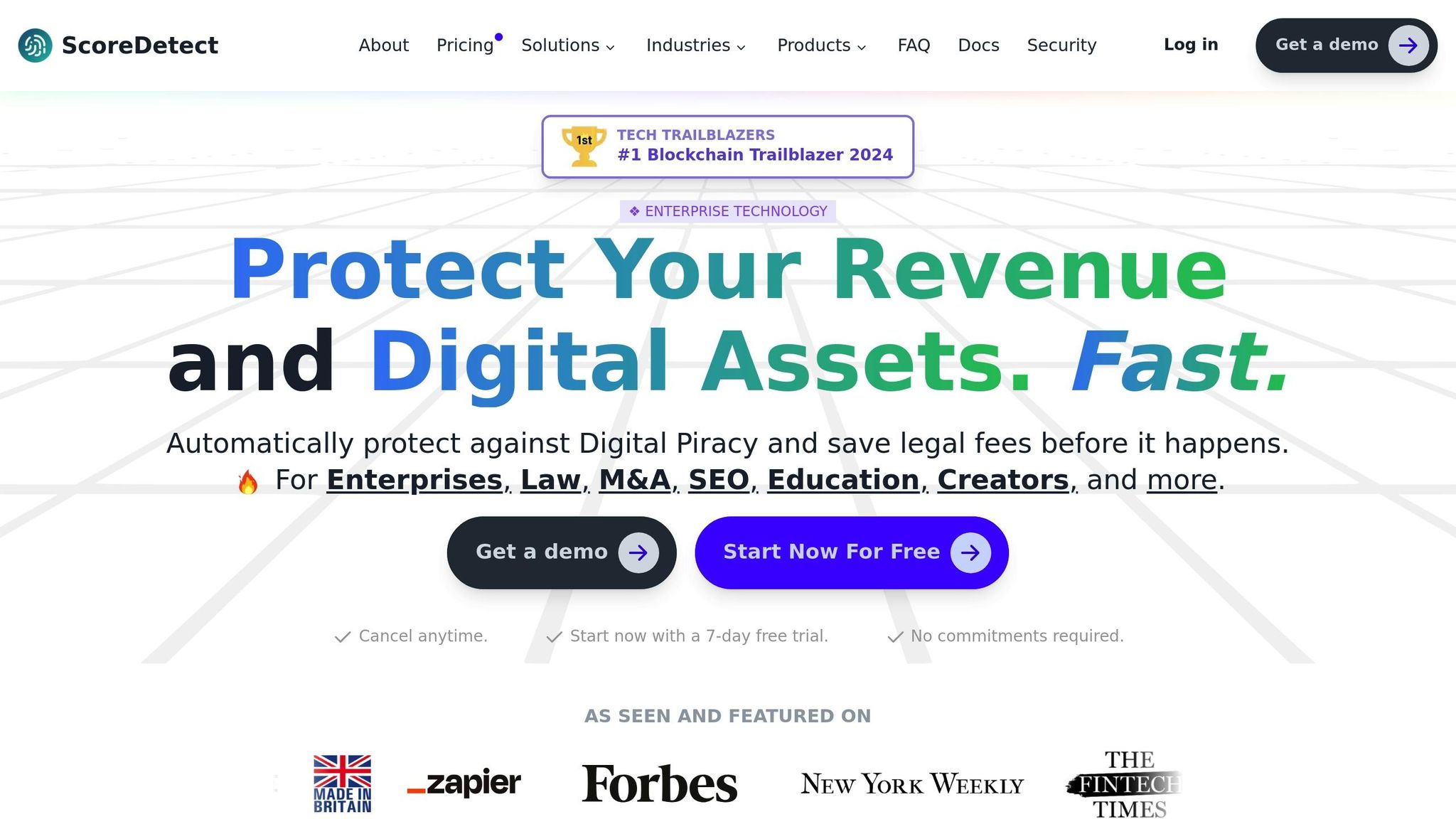AI is reshaping piracy detection in 2025, tackling a $75 billion annual problem in video piracy alone, rising to $125 billion by 2028. Industries like media and software face massive losses as pirates use AI to bypass protections, scrape content, and erase watermarks. Traditional methods can’t keep up, but AI-driven solutions ensure faster, smarter detection and enforcement.
Key Takeaways:
- AI tools scan billions of transactions in seconds to detect piracy.
- Invisible watermarks and blockchain secure content ownership.
- Automated systems send takedown notices and block infringing material.
- Pirates now use AI to evade detection, erase watermarks, and scale operations.
Example Solution: Platforms like ScoreDetect combine AI and blockchain to prevent piracy, offering invisible watermarking, real-time monitoring, and automated enforcement for as little as $11.31/month.
As piracy evolves, AI remains essential for protecting digital assets. Businesses must adopt smarter tools to stay ahead.
How to use AI to fight video content piracy threats
Key AI Technologies for Piracy Detection
The battle against digital piracy hinges on three primary AI technologies working together to create a strong defense system. With the ability to process massive daily data streams, these technologies enable swift and precise detection of unauthorized content [4].
Automated Content Monitoring
AI-powered systems operate around the clock, scanning websites, social media platforms, streaming services, and file-sharing networks on a global scale [4]. Unlike older methods that relied on manual searches or basic keyword filters, these advanced systems leverage machine learning, natural language processing (NLP), and computer vision [4] to identify pirated material in all its variations.
Even when pirates attempt to disguise content by tweaking file names, altering metadata, or making minor edits, AI’s pattern-matching capabilities can recognize the original material [4]. These systems process data in real-time, which traditional security methods often struggle to achieve. While older approaches are limited by delayed responses and scalability issues, AI-driven tools deliver high accuracy and continuously improve through adaptive learning [4].
Beyond detection, these systems also automate the next steps. For instance, they can send takedown notices and remove infringing content from search engine results [4]. Additionally, through pattern recognition and predictive analytics, AI can anticipate piracy behavior, refining detection methods and allowing for proactive measures [6].
Pattern Recognition and Predictive Analytics
Machine learning plays a critical role in spotting anomalies and patterns that hint at piracy [6]. By analyzing enormous datasets, these systems can uncover behavioral trends, metadata inconsistencies, and unique content fingerprints tied to unauthorized use.
Predictive analytics takes this a step further by identifying potential piracy hotspots. By studying past incidents and trends, AI can detect early signs of piracy campaigns, enabling content owners to strengthen their defenses in vulnerable areas [6].
AI doesn’t just match content – it provides a deeper, contextual understanding, distinguishing between fair use and copyright infringement [4]. This reduces the false positives that often plague traditional detection methods. Enforcement algorithms, combining machine learning, content analysis, and blockchain, block unauthorized content use [5]. These algorithms analyze metadata, apply fingerprinting, and use behavioral analytics to automate enforcement actions, such as deploying smart contracts [5].
AI’s ability to learn and adapt ensures these systems stay effective against emerging forms of content fraud without constant manual updates. As one expert from Viaccess-Orca put it:
"Removing the incentive for consumers is one of the most effective ways to deal with content piracy, potentially deterring users from seeking pirated content." [6]
Blockchain Integration for Content Protection
When paired with blockchain, AI creates a powerful system for verifying content ownership. Blockchain technology enables the creation of tamper-proof records that can serve as legal evidence in piracy cases [4].
One example of this integration is ScoreDetect, which combines AI and blockchain to establish secure ownership records. By recording content checksums on the blockchain, ScoreDetect provides verifiable proof of ownership without storing the actual digital files. This approach not only ensures legal protection but also maintains privacy and reduces storage costs. Additionally, blockchain enhances digital security with advanced encryption and decryption capabilities [4].
Together, AI and blockchain form a multi-layered defense system that is incredibly difficult for pirates to bypass. This combination not only detects piracy quickly but also secures content ownership with irrefutable evidence, creating a comprehensive solution for content protection.
How Pirates Use AI to Avoid Detection
As AI becomes a powerful tool for detecting piracy, pirates are flipping the script and using the same technology to outsmart detection systems. This shift highlights how AI can be a double-edged sword – just as it aids in enforcement, it also provides pirates with advanced tools to stay one step ahead.
AI-Powered Evasion Tactics
Pirates are now using AI to fine-tune their operations and fly under the radar. For example, they manipulate stolen video content with AI to avoid recognition systems entirely [1]. Machine learning is also being employed to erase watermarks from protected materials, stripping away one of the key methods of content protection [1]. On top of that, AI-driven tools are capable of bypassing encryption and digital rights management (DRM) by exploiting weak points in access controls [1].
Automation plays a big role, too. AI-powered bots are streamlining piracy by automating tasks like scraping content, uploading files, and managing entire distribution networks [1]. These bots even mimic legitimate user behavior, using real-time adaptive AI to constantly refine their evasion techniques [7].
Challenges in Combating AI-Driven Piracy
Fighting piracy has never been easy, but AI-enabled tactics present a whole new set of challenges. One of the biggest hurdles is real-time adaptation. AI-powered attacks can quickly adjust their methods, creating unpredictable patterns that are tough for security systems to catch [7].
The scale of these attacks is another issue. With the growing availability of AI tools, pirates can now automate their operations on a massive level. Generative AI, for instance, allows adversaries to streamline attack research and execution, making it easier to scale their efforts [7].
AI is also speeding up reconnaissance efforts. Pirates are now using it to identify high-value targets within organizations, making their attacks more focused and effective than ever before [7].
Outdated regulations add yet another layer of difficulty. The fast-paced evolution of AI-driven evasion techniques makes it hard for legal frameworks to keep up. This creates loopholes that pirates are quick to exploit, leaving rights holders and regulators scrambling to adapt [8].
This ongoing tug-of-war between pirates and anti-piracy efforts underscores the need for constant innovation. As piracy tactics evolve, anti-piracy measures must evolve just as quickly to keep up. It’s a high-stakes race where staying ahead is the only option.
sbb-itb-738ac1e
AI Anti-Piracy Solutions in Action
As piracy becomes more sophisticated with the help of AI, anti-piracy tools are stepping up their game, using cutting-edge technology to detect, prevent, and counteract piracy in real time. These advancements are reshaping how creators and businesses safeguard their digital content.
Invisible Watermarking and Proof of Ownership
Visible watermarks have long been a go-to for content protection, but they’re no match for modern AI tools that can easily remove them. Enter invisible watermarks – a game-changer in digital security. These watermarks are embedded directly into the pixels of images, videos, and audio files without compromising quality. What makes them so effective is their resilience; they remain intact even after resizing, compression, or cropping, unlike traditional metadata that can be stripped away[9].
In March 2025, tests showed that while visible watermarks were easily removed by AI, invisible watermarks stayed detectable[11]. These advanced watermarks are further strengthened by encryption, adding extra security layers that can trace leaks and pinpoint the source of unauthorized distribution[10][9]. They seamlessly integrate with automated enforcement systems, making them a vital tool in modern copyright protection.
Automated Takedown Notices
Manually identifying copyright violations and sending takedown requests is no longer practical in today’s fast-paced digital world. AI-powered takedown systems have revolutionized this process, using sophisticated algorithms to scan for infringements and automatically generate DMCA notices. This dramatically reduces the time it takes to respond to piracy[10].
For example, between May 28, 2014, and February 22, 2015, Total Wipes sent over 41,000 takedown requests, covering nearly 197,000 URLs, with a median of 1,214 requests per week[12]. However, automation has its pitfalls. The Electronic Frontier Foundation (EFF) has raised concerns about errors in automated notices, citing a 2015 incident where a system mistakenly flagged an EFF webpage about PGP encryption as infringing on an album titled "Cigarettes." The error stemmed from a bug in the anti-piracy script[12].
Despite these challenges, platforms like YouTube demonstrate the potential of automation, claiming that 99.5% of infringing music videos are resolved by its Content ID system[13]. These advancements pave the way for integrated platforms like ScoreDetect, which combine automation with precision.
Case Study: ScoreDetect

ScoreDetect is a prime example of how AI and blockchain can join forces to combat piracy. Founded by Michael Bryan Sumner, the platform serves over 40,000 users across industries such as content creation, healthcare, and legal services[15].
The platform operates on four key pillars:
- Prevention: Invisible watermarking protects content without altering its appearance.
- Discovery: AI-powered web scraping identifies unauthorized content with a 95% success rate.
- Analysis: Automated tools provide clear, quantitative proof of infringement.
- Takedown: Automated notices achieve a 96% takedown success rate.
What sets ScoreDetect apart is its use of blockchain for content verification. By storing checksums on the blockchain, it offers tamper-proof proof of ownership, including creation dates and authorship[14]. The system is fast and efficient, generating verification certificates in an average of 3.856 seconds and integrating with over 6,000 apps via Zapier[14].
Users have praised ScoreDetect’s effectiveness. Imri, a SaaS startup CEO, shared:
"ScoreDetect is exactly what you need to protect your intellectual property in this age of hyper-digitization. Truly an innovative product, I highly recommend it!"[14]
Kyrylo Silin, another SaaS founder, added:
"With ScoreDetect, I can take pictures for my travel blog and be confident that nobody will claim them as theirs. I can always prove that I am the author."[14]
Starting at $11.31 per month with a 7-day free trial, ScoreDetect offers a comprehensive solution for businesses and individual creators alike. By combining invisible watermarking, AI monitoring, blockchain verification, and automated enforcement, it represents a powerful tool for fighting digital piracy[16].
The Future of AI in Piracy Detection
The ongoing clash between content creators and pirates has reached a new level, with AI becoming a key player on both sides. As pirates increasingly leverage AI to bypass traditional security measures, the future of protecting digital content hinges on constant innovation and smarter strategies. This rapidly shifting landscape requires not just advanced detection systems but also a relentless push to stay ahead with new protective measures.
The Need for Constant Advancement
Pirates are evolving their tactics at breakneck speed, using AI to develop sophisticated methods that challenge conventional security systems. One example is the automation of content scraping through AI, which makes it easier for pirates to exploit vulnerabilities. To combat this, solutions like polymorphic protection are gaining traction. This approach involves software updates that continuously adapt, making it harder for pirates to find consistent workarounds [1].
The stakes are high, as highlighted by the 2017 WannaCry ransomware attack. This incident impacted hundreds of thousands of computers, with many running pirated operating systems, showing how piracy can lead to massive security breaches [2].
Maria "Mascha" Malinkowitsch, the director of product management for Counterspy at Verimatrix, stresses the importance of fighting fire with fire:
"AI must be embraced as a tool to use against AI-based piracy. After all, if pirates depend upon AI, so should you to maximize the protections for your high-value content." [1]
This highlights the critical need for content protection providers to continuously refine their AI capabilities. Machine learning, in particular, plays a vital role in identifying unusual patterns in license usage and detecting emerging piracy techniques [2].
Best Practices for Businesses
To stay ahead, businesses need to adopt a well-rounded approach that combines cutting-edge technology, legal measures, and collaborative efforts [3].
Real-time monitoring is a cornerstone of modern content protection. AI-driven systems can analyze massive datasets to detect piracy trends and anomalies, enabling businesses to respond quickly to threats [2]. Equally important is fostering a workplace culture that prioritizes security. This includes regular employee training, clear processes, and a focus on accountability, all of which help create an environment where digital assets are actively protected [6].
Integration is another key factor. Anti-piracy solutions must seamlessly fit into existing workflows to ensure consistent and effective protection [1].
Tools like ScoreDetect offer businesses a range of capabilities, including invisible watermarking, advanced monitoring with a 95% success rate, blockchain-based verification, and automated takedown notices that achieve a 96% success rate. These technologies provide a robust defense against piracy.
However, staying ahead of evolving piracy tactics requires ongoing improvements in AI. Companies must also navigate the ethical and legal challenges that come with advanced AI tools, such as ensuring data privacy, maintaining algorithmic transparency, and enforcing policies fairly. As Viaccess-Orca points out, reducing consumer incentives to engage in piracy remains one of the most effective strategies for tackling the problem [6].
FAQs
How does AI differentiate between fair use and copyright infringement in piracy detection?
AI technology plays a crucial role in determining whether content usage falls under fair use or crosses the line into copyright infringement. By examining factors like the context, purpose, and extent of the usage, these systems can evaluate if the use is transformative, non-commercial, or appropriately limited.
This kind of detailed analysis helps minimize errors in piracy detection while ensuring adherence to copyright laws. For instance, AI can assess whether content has been reworked to add new meaning or value, aligning with fair use principles, or if it unlawfully duplicates the original work without proper authorization.
How does blockchain help protect digital content from piracy?
Blockchain enhances the protection of digital content by establishing a secure and unchangeable ledger that tracks ownership and usage. This system ensures a clear record of content origins, making it extremely difficult to modify or falsify any records.
Instead of storing the actual files, blockchain captures a unique checksum – a digital fingerprint of the content. This serves as proof of ownership that can be verified, adding an extra level of security. As a result, copyright protection is strengthened, and piracy becomes much harder to execute.
What steps can businesses take to effectively use AI tools to combat digital piracy?
To tackle digital piracy head-on, businesses can turn to AI-driven tools that provide real-time monitoring, invisible watermarking, and automated takedown features. These tools are designed to quickly spot unauthorized content and act on it with precision.
On top of that, using platforms equipped with advanced web scraping and instant alert systems allows companies to identify piracy attempts as they happen. By staying one step ahead of ever-changing piracy methods, businesses can safeguard their digital assets and maintain stronger content protection.

